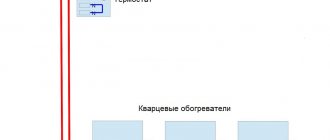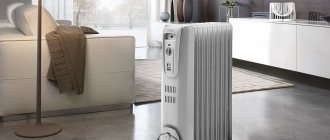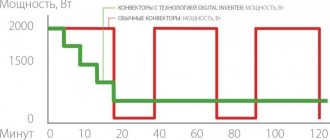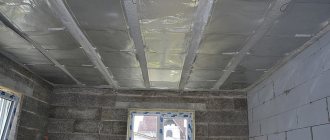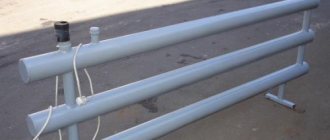Infrared heaters differ from other heating devices in that they can be used for spot, zone heating. This possibility is due to the specific operation of this equipment. Quartz infrared heater is one of the most popular devices that attracts consumer attention with its high efficiency.
What are quartz infrared heaters?
There are two types of quartz heaters on the heating equipment market:
Despite the fact that both types of devices operate on the basis of quartz, their heating principle is different. MKTENs are slabs containing quartz sand. When heated, they transfer heat to the air, and it spreads throughout the room.
Infrared heats not the air, but objects with a hard and relatively hard surface. From them, heat spreads to the nearest space.
What is it for and where is it used?
The quartz infrared heater is suitable for general use. Devices of this type are most beneficial for creating a comfortable microclimate in rooms with insufficient quality insulation, in through-ventilated corridors, and in places with high traffic.
Most common applications:
- shopping pavilions;
- country houses with seasonal accommodation;
- showcases;
- summer cafes;
- Living spaces;
- garages;
- offices.
How it works: device and principle of operation
They are called quartz devices because the emitter in them is a tube made of quartz glass. A thin spiral-shaped tungsten wire is used for heating. It is located inside glass tubes from which air has been removed.
Operating principle of a quartz heater:
- the tungsten spiral heats up and transfers heat to the glass;
- the tube on the back side is covered with a reflective layer, ensuring unidirectional propagation of IR rays;
- infrared radiation reaches various surfaces and begins to heat them;
- objects transfer heat to the space around them.
A significant drawback of devices of this type is the fragility of the emitter. The tubes heat up to high temperatures and can crack if exposed to moisture. Sudden temperature changes are also undesirable for these devices. Typically, the warranty for quartz IR heaters does not exceed 1.5 years. This technique requires careful and careful handling.
Mounting methods
The range of quartz infrared heaters includes floor, wall and ceiling models. Moreover, the last two categories are interchangeable. That is, if a manufacturer positions its device as wall-mounted, it can also serve as a ceiling-mounted one. The heaters are equipped with special mounting brackets.
Ceiling fixtures are supplied with hangers. They are installed in special grooves in the body, after which they are put on hooks mounted on the ceiling.
Wall-mounted models are installed on consoles and brackets. The mounting elements are attached to the wall, after which the device is fixed to them. Floor-standing devices can be installed on any flat horizontal surfaces.
Reviews of quartz infrared heaters: pros and cons
According to user reviews, quartz IR heaters have their disadvantages:
- since the glass tube is heated to high temperatures, the dust that falls on it burns and a specific odor is formed;
- Due to the relative fragility of the emitter, drops of water should not be allowed to get inside the housing.
But the devices have much more advantages:
- rapid heating of the room;
- high efficiency;
- the air is not dried because it is not heated;
- compactness;
- stylish design;
- modern models have many useful options that increase ease of use.
Open infrared emitters or monolithic panels?
Due to the high heating rate, quartz heaters are often purchased for use in cottages and garages during the cold season. Moreover, infrared ones in this regard are much more effective than quartz monolithic ones. But the latter are more profitable because they give off heat for a long time. And when you turn off the infrared, objects heated by it quickly cool down.
The following conclusions can be drawn:
- monolithic panels are beneficial due to their high heat capacity;
- infrared - heating rate.
Manufacturers and popular models: ranking of the best and prices
The vast majority of heating equipment manufacturers also offer quartz IR heaters. These are NOIROT, EWT, Stiebel Eltron, AEG, “Comfort”. The range of these companies includes devices that have proven themselves to be the best in this category of climate control equipment.
Noirot Royat 2 1200

The heater is equipped with a waterproof housing and is recommended for use in rooms with high humidity, on terraces, in gazebos, on balconies and loggias. Has electrical safety class II. There is a power switch on the top panel. The model is designed for wall mounting and is capable of serving areas up to 15 m2.
- three power levels - 300/600/1200 W;
- geometric parameters - 120x110x450 mm;
- weight - 1.3 kg.
Quartz or infrared heater: Selecting a heater
Infrared heater
In general, all thermal heaters that use the transfer of thermal energy in their principle are infrared. This is explained by the fact that the heat of a stove, a boiler, the heat of a table heated by the sun - all these phenomena emit in the infrared spectrum. This diffraction distribution spectrum can only be seen with special glasses.
But there are also infrared heaters with direct radiation of the infrared spectrum, similar to ultraviolet rays. These devices have a very unique design and operating principle.
So, when choosing a Quartz or infrared heater, you should consider the following data.
How it works
To understand what is better in devices, as well as some reasoning and evaluation, you need to know how an oil and infrared heater work. Design features and the method of heat transfer in some cases dictate both the rules of operation and the principles of placing devices in the room.
- Oil heater. As the name suggests, transformer oil is used as the coolant of the device. This is a special composition that does not cause corrosion of heating elements, does not make rubber seals hard, has zero conductivity and is thoroughly cleaned. The coolant is located in a sealed volume. Depending on the design of the heater, it can be one large flat panel or several small ones. Heating is carried out by a heating element in the lower part. The oil cooler provides universal protection against emergency situations. A physical fuse controls pressure and temperature. When the heater enters emergency mode, a special unit completely stops operation, interrupting the power circuit, preventing the oil from rupturing the radiator. The heating intensity is smoothly set by a mechanical thermostat, which contains a bimetallic plate. The operation of the oil cooler controls and adjustments is precise, the system does not require maintenance, and spare parts are available and cheap.
- Ceramic, micathermic, quartz or carbon heater. Infrared heaters are built on different types of emitters. It is simply impossible to say in a nutshell what is better - a carbon or classic infrared heater. They have the same operating principle, but different types of emitters have their own characteristics. For example, a bulb with a carbon filament burns with a visible reddish light, a halogen lamp emits a golden light and is coated with special compounds for protection, devices with ceramic plates, as well as heating elements inside a solid block of material (quartz) work only in the invisible spectrum. The operation of an infrared heater can be compared with spotlight. It has an effective energy dissipation angle. Roughly speaking, the device radiates to everything within its viewing area. When it comes to heat, an infrared heater is like a fire. Some people don't like the mechanics of how it works. They describe their feelings with the following phrase: their face is hot, but their back is freezing. Actually, this fully reflects the operating method of the thermal emitter. The operation of expensive models is regulated using remote devices. Thermal sensors placed in the room give a command to turn the heater on or off. Cheap models are equipped with simple regulators that only switch the number of heaters without monitoring the temperature in the room in any way.
From the above it follows: an oil heater is more convenient in terms of adjusting the heating intensity. At the same price of devices, the infrared device has stepwise switching: one emitter, two, three. Oil allows for smooth adjustment within each stage, which allows you to fine-tune the heating mode.
Design of infrared thermal emitters
In order to understand the kinematics of the process and the design of an infrared device, it is necessary to imagine the most typical ultraviolet lamp. This device is equipped with several similar high-power lamps that are capable of providing laminar heat flow in the invisible radiation spectrum.
The lamps are mounted on a special frame and are flat or cylindrical rods, the operation of which is ensured by the supply of electric current from the general network through a step-down transformer. A reflector can be installed in front of the lamps to direct the flow, as well as its amplifier in the form of a flat-convex lens.
How to choose a halogen heater
When choosing a heating device, be guided by the following requirements:
- 10 m2 requires 1000-1300 W of power;
- the case must be aesthetically pleasing, functional, have an insulator, a safety button and a grounding device;
- device reliability;
- safety of the inner flask;
- the device must have an overheating sensor and a temperature control toggle switch;
- quality of halogen device, manufacturer's reliability, warranty service.
Operating principle of infrared heaters
As already mentioned, the design uses lamps with specific infrared radiation. This radiation is capable of heating surrounding objects in the immediate vicinity due to laminar (constant) heat transfer. Gradually heating up, objects themselves become a source of heat. This is the basic principle of operation of this heater.
Pros and cons of the product
The undoubted advantages include the following characteristics:
- The heater uses a modern heating method, ultraviolet lamps and infrared lamps are energy efficient and require a minimum of electricity;
- Lamp safety. They do not contain mercury vapor or liquid metal, so they can be disposed of as household waste.
The heater has some specific applications in industrial and domestic matters. This forms one “big plus” in comparison with other models. Application Variations:
- Ideal for use in clothes dryers, e.g. industrial facilities. The effect of a heat gun is created, but without a moving air flow with heat transfer;
- Used in car paint shops. lamps heat the surface evenly and lead to faster drying;
- For preparing vegetables if they require quick drying;
- Application for some specific repair work. It can become an analogue of a hair dryer for disassembling smartphones, microcircuits and other digital devices.
The disadvantages still prevail:
- When placed in an empty position, this heater will begin to warm up the walls, this does not always lead to success, for example, in a cold room in winter;
- The design of the lamps is fragile and is not designed to withstand impacts when carried;
- The heater does not provide for wall mounting;
- Relatively high price for the model;
- Fragility. The design itself and the infrared lamp lead to the fragility of the device.
Terms of use
The simplest daily care for halogen ceiling-type devices is that they are inaccessible to mechanical damage and children, and therefore only require maintenance of cleanliness.
Wall-mounted and floor-standing models must be located at a distance of at least 1 m from surrounding objects; placing any objects on the heaters for drying or heating is strictly prohibited. In addition, it is also prohibited to cover heating devices with anything, as this can lead to ignition of the coating, thermal burns from contact with it, or overheating of the device.
You should not be exposed to radiation for a long time in the immediate vicinity of the heater - you can get burned. In addition, the radiation of halogen lamps is short-wave, and its prolonged exposure to humans is undesirable.
Important! If the area of the heated room is significant, then the optimal way to ensure a comfortable temperature in the room would be to use several low-power halogen heaters, since the use of one device with a total power has more negative factors.
It is advisable to purchase a halogen heater with lamps that have a special coating that weakens their glow when heated.
Ceramic heater
Monolithic quartz heaters (abbreviated as KOMT) are a quartz monolith in the form of a slab. To make it, a mixture of yellow quartz or quartzite with ceramic clay is used. A thermal heating element is placed in the stove, which is made of nichrome or an alloy of nickel and chromium in different proportions. This alloy has a very high tensile strength and heat resistance, and most importantly, excellent heat transfer properties.
The heater operates from a regular electrical network of 220 volts.
Technical characteristics and parameters
Most quartz heaters are produced according to a single standard, so the main overall dimensions of a quartz plate are 60 cm in length, 30 cm in height and 2.5 cm in thickness. Weight does not exceed 10 kg.
0.3-0.5 kW is the rated positive power of the heating element at the moment of heat transfer to quartz. The same amount is consumed by the heating system from the electrical network in 1 hour.
The maximum heating temperature of the stove is 90–95 °C. It only takes 15-20 minutes to warm up the stove itself to operating temperature from a cold state. Room 15 sq. m heats up to 32 °C in just half an hour after heating the stove.
How to make a heater from halogen lamps
It is not difficult to make a fireproof heater from a halogen lamp with your own hands, having detailed instructions at hand. You can get an electric device on which it is safe to dry clothes, shoes and other items. Device power 1 kW.
To work you will need:
- metal container with a volume of 10-20 l;
- halogen lamp;
- metal corner;
- electrical cable;
- reflector or brick.
A metal paint container or can is suitable for the device. Legs from a metal corner are attached to the base.
A metal container is placed on the corners and placed on an iron base
An electric cable is connected to the lamp. A brick is placed inside the container, on which a halogen lamp is installed. Brick provides additional heating to the room.
1000 W halogen lamp is the most suitable option
The temperature on the surface of the device reaches 50 0C. You can touch it with your hand without the risk of burns and dry clothes and shoes.
A halogen lamp heater is safe
The device produces a large amount of heat to heat the room. Through the hole you can see how bright the light is emitted by the lamp.
Quartz or infrared heater, which is better?
Characteristic differences from other types:
- positive economic effect;
- huge thermal capacity;
- an alloy of chromium and nickel (nichrome) is characterized by great durability;
- an innovation called the “heated brick effect” was applied. Studying this effect, the developers came to the conclusion that the use of a quartz slab makes it possible to most effectively convert the energy of electric current into heat;
- After calculating the efficiency, it was found that one stove of standard overall dimensions can heat an area of 15 square meters of room space. m;
- It is possible to use various types of automation and electronic control systems. Connecting temperature and humidity sensors allows you to organize the operation of the heating system, adjusting to changing climatic conditions in the room;
- have proven themselves perfectly in use for country houses and dachas. At the same time, the use of automatic regulators allows you to maintain the heat temperature even after leaving the dacha, for example, 10–15 °C. The use of the device in dryers and garages is similar;
- when operating, they do not burn oxygen in the room, like infrared heaters.
Components
The use of quartz slabs is justified by the excellent properties of heat transfer and heat retention during very long cooling. The slab is made from a mixture of quartz, Portland cement of the highest quality and low dispersion, as well as quartz sand.
The durable quartz fraction is crushed to crumbs of no more than 2 millimeters, it is sprinkled with quartz sand and Portland cement. Under the influence of temperature, all fractions in the molding matrix merge. Two halves and a half of the cavity described above are made. Afterwards, a heat exchange element and coolant are placed into the cavity. The two plates are closed and connected under the influence of temperatures. An electrical plug and cord are attached to the exchanger.
Quartz or infrared heater, which is better?
The heat exchange element is a cavity made of metal that fits tightly into a cavity inside the quartz. The metal cavity is made of an alloy of nickel and chromium or nichrome with refractory additives. The diameter of the cavity is no more than 3 centimeters, and a metal rod made of the same alloy is rigidly installed strictly in the center. This is the coolant with current supplied to it. Essentially, everything resembles the spiral of an electric kettle, which is placed in a metal cavity, which in turn is placed in a cavity inside a quartz plate.
We make a choice: infrared or quartz heater
To summarize the information, all criteria and their indicators will be given in the table:
| Criterias of choice: | Infrared heater | Quartz heater |
| 1. Energy efficiency | Efficiency less than 0.98 | The efficiency is greater than 0.98 and can be increased by using additional plates to heat large areas. |
| 2. Heating temperature | The temperature does not exceed 70 degrees Celsius. There is no cooling period for the heater; third-party objects give off heat depending on the material used. | Reaches 90 degrees Celsius, followed by a long cooling. |
| 3. Environmental friendliness | Environmentally friendly | Environmentally friendly |
| 4. Durability | Weak, lamps are susceptible to easy destruction at the slightest impact | The quartz slab has a high limit to destruction and chipping. a fall from the installation height (usually 160 cm from the floor) cannot cause the slab to break |
| 5. Technology and technical parameters | Complex composition, complex technical component in the form of lamps | A minimum of components is used, all designs are simple, a primitive method of converting electrical energy into heat is used |
| 6. Fire safety | Transfers heat to all surfaces, including flammable ones. There is a risk of fire if you are not careful. Dust accumulated on the lamp may ignite. | Completely fireproof. The texture of ceramics and quartz differs from metal in that even with direct contact with the surface it cannot ignite it. dust on the surface of a quartz slab will not ignite even with extreme heating up to 90 degrees Celsius |
| 7. Automatic equipment | In this case, such equipment is impractical, since periodic infrared heating of the surface will not lead to constant heat transfer. The surface will not heat up and the room will not be heated | It has the broadest prospects for equipping with various means of adjustment and automatically. Options include: adjusting the time of heat supply, automatic shutdown based on time and temperature, creating a cyclical process. |
As can be seen from the table, almost all parameters have their positive side regarding quartz-type heaters. These parameters are fundamental, but there are others that also speak in favor of the latest device:
- Aesthetic appearance;
- Various variations of installation and design (floor-mounted, wall-mounted, convector);
- Multifunctional use for various areas (indoor and outdoor areas).
Advantages and disadvantages of quartz heaters
| Advantages | Flaws |
| Does not burn oxygen because the heated tungsten filament is hidden in a quartz tube. | A feature of IR radiation is local heating: whatever the rays hit, they heat. If you're sitting at a desk and only the upper half of your body is within range of the IR waves, your feet may get cold. |
| With infrared heating, warm air does not accumulate under the ceiling (as happens when using a convector). There is no situation where your head is hot and your feet are cold. | A quartz bulb can break if dropped or hit, and it is very difficult to repair or replace it - it’s easier to buy a new heater. |
| Allows you to “heat up” exactly those areas where people are located. The temperature created by the main heating system can be reduced, which means energy consumption and heating costs can be reduced. | Appearance. The IR lamp is visible behind the protective grille. |
| IR heaters are mobile, lightweight and compact. | As soon as you turn off the heater, it stops giving off heat: no radiation - no transfer of thermal energy. |
| The device quickly heats objects in the room. They are not equipped with a fan, which means they operate silently. | |
| Demonstrate high performance with low power consumption. |
Quartz heaters of the ThermoQuartz brand
When choosing a quartz or infrared heater, it is worth noting separately from the entire line of quartz heaters the Belarusian-made brand “ThermoQuartz”. We recommend the products of this company for purchase based on a number of positive criteria:
- quartz heaters of the ThermoQuartz brand are distinguished by their enormous energy intensity and are capable of heating rooms efficiently and for a long time, not only when turned on, but also during a period of prolonged cooling;
- A stone quartz heater is practically indestructible and has excellent strength characteristics: it is very difficult to split even under strong mechanical stress, and cannot be scratched;
- Absolutely environmentally friendly thanks to the use of natural materials. Quartz and quartz sand of various fractions are completely non-toxic, and even vice versa - quartz lamps are used to treat the thyroid gland;
- guaranteed safety. Complete fire safety and ergonomic installation anywhere on a load-bearing wall.
[/vc_column_text][/vc_column] Products of the ThermoQuartz brand, manufactured in the region.
Belarus, represent an excellent combination of quality and functionality. To purchase, you can call the contact number and contact the operator in Moscow, or you can directly contact the official dealer’s address: Moscow, Vysokovoltny proezd, 13A, office 9 Don’t miss out on your benefits, contact us, find out all the possible nuances and purchase high-quality and functional heaters.
Reliable and fast delivery to the regions of the Russian Federation is available. Buy ThermoQuartz quartz heaters and enjoy comfort and warmth when there is bad weather outside. [ratings]
Share: Facebook Twitter LinkedIn Google + Pinterest Tumblr
Advantages and disadvantages
The compared devices have common pros and cons (discussed in detail here). However, the different structures and operating principles revealed the individual strengths and weaknesses of the devices. This makes it possible, by comparing their advantages and disadvantages, to draw preliminary conclusions: which is better - a quartz or infrared heater.
Quartz heater
The quartz panel has many positive aspects:
- high efficiency - device efficiency is 75-95%;
- rapid heating of the panel - about 20 minutes, after which there is an intensive heating process;
- simple design - there is simply nothing to break;
- simple and quick installation on the floor or wall;
- large thermal capacity, allowing you to maintain a comfortable temperature in the room for a long time after switching off;
- high level of tightness, allowing the device to be used in rooms with high humidity;
- long service life - from 20 to 30 years;
- silent operation (when ceramics are added to the panel, crackling noise is sometimes heard when heating and cooling);
- Voltage fluctuations or short-term power outages do not affect the quality of heating - the panel that has accumulated heat saves the day;
- good design that allows the device to fit into the interior without problems;
- it is possible to connect various types of automation in the form of climate control or thermostat, which will significantly increase the efficiency of the quartz stove;
- ability to work from a smart socket - turned on and off by smartphone.
disadvantages :
- quite high price;
- the weight of the panel makes it difficult to transport and hang on the wall - not every panel can withstand such a load;
- The package does not include a thermostat (only a dozen out of several hundred models have it);
- increased electricity consumption, which does not coincide with the passport data (there, as a rule, power and electricity consumption are equalized, which does not correspond to real consumption due to natural losses);
- like all heaters, it dries the air, although manufacturers claim the opposite;
- fragility of the panel;
- If the heating element fails, the device cannot be repaired;
- high temperature of the surface of the case - you can get burned;
- budget options have an unattractive appearance and a short service life.
Infrared heater
advantages of quartz reflectors :
- affordable prices;
- rapid heating of rooms;
- high efficiency - 87-95% (the ceiling space is not heated);
- there are no convection currents that raise dust into the air;
- almost uniform heating of the room along the height. At the same time, the temperature in the floor area is always higher, which ideally fits the proverb “keep your head cold and your feet warm”;
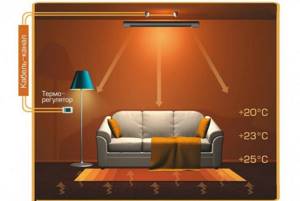
- easy installation;
- light weight, allowing you to easily move the device from room to room or transport it to the dacha and back;
- long service life;
- maintainability - a burnt or damaged tube can be replaced;
- no maintenance required;
- You cannot get burned on the reflector body;
- compact dimensions allowing you to place the device on a windowsill;
- has the effect of a heat gun - allows you to quickly and evenly dry walls, clothes, a painted car, etc.;
- interesting design - can always be matched to a decorated interior;
- safe operation, including automatic shutdown when tipped over, a grille on the front side (prevents burns), no harmful fumes if the flask is damaged.
some disadvantages . What would it be like without them:
- long-wave radiation is harmful to humans. Therefore, the heating of the spiral should not exceed +300oC (maximum possible temperatures – +1200oC);
- prolonged exposure to direct rays on the human body causes unpleasant sensations. Therefore, the bed should not be in the direct radiation area;

Nice picture, but it shouldn't be like that.
- There is a thermostat built in, but this is pointless, because... greatly reduces the efficiency of the device - shutdowns do not exceed 10 minutes, and heating the coil requires additional electricity;
- rapid cooling of the room when the device is turned off;
- Red light at night has a negative impact on a person’s mental state—lethargy and apathy appear in the morning. A night light will help you avoid problems, but this will add additional energy costs.
